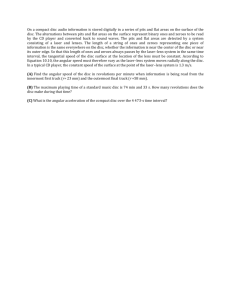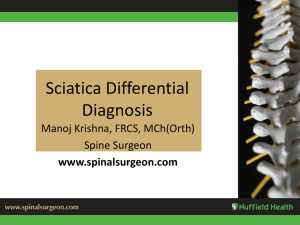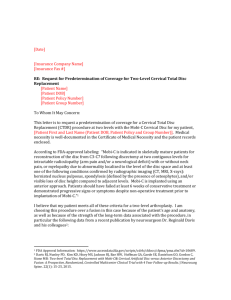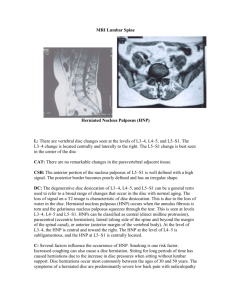Doc - Shaw Chiropractic
advertisement
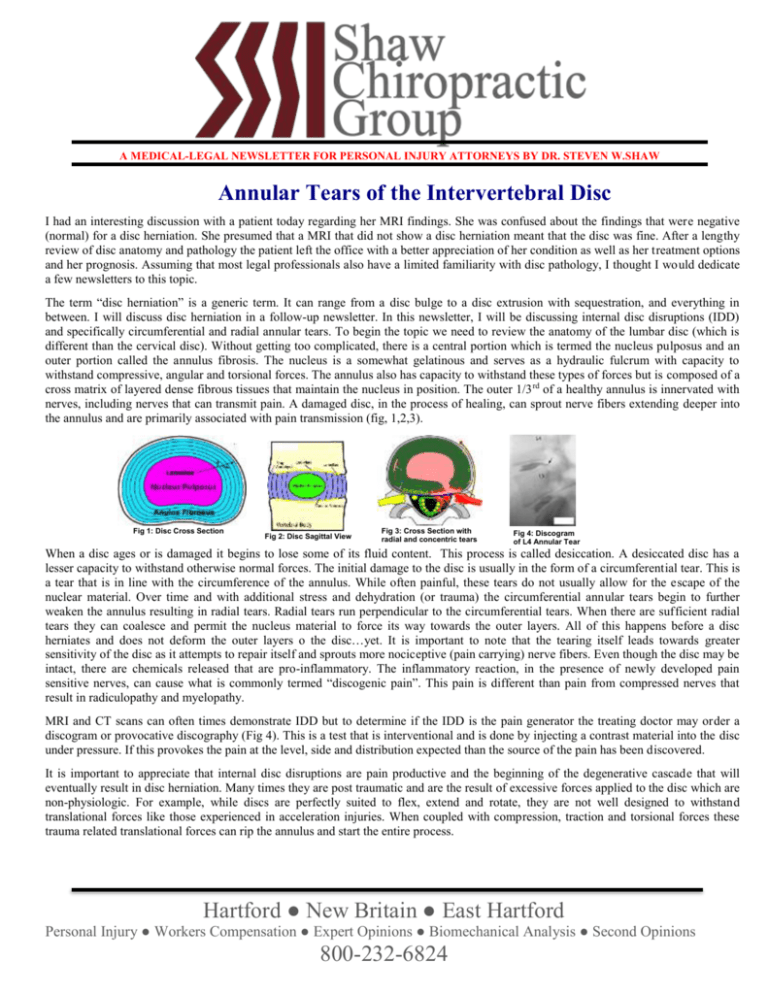
A MEDICAL-LEGAL NEWSLETTER FOR PERSONAL INJURY ATTORNEYS BY DR. STEVEN W.SHAW Annular Tears of the Intervertebral Disc I had an interesting discussion with a patient today regarding her MRI findings. She was confused about the findings that were negative (normal) for a disc herniation. She presumed that a MRI that did not show a disc herniation meant that the disc was fine. After a lengthy review of disc anatomy and pathology the patient left the office with a better appreciation of her condition as well as her treatment options and her prognosis. Assuming that most legal professionals also have a limited familiarity with disc pathology, I thought I would dedicate a few newsletters to this topic. The term “disc herniation” is a generic term. It can range from a disc bulge to a disc extrusion with sequestration, and everything in between. I will discuss disc herniation in a follow-up newsletter. In this newsletter, I will be discussing internal disc disruptions (IDD) and specifically circumferential and radial annular tears. To begin the topic we need to review the anatomy of the lumbar disc (which is different than the cervical disc). Without getting too complicated, there is a central portion which is termed the nucleus pulposus and an outer portion called the annulus fibrosis. The nucleus is a somewhat gelatinous and serves as a hydraulic fulcrum with capacity to withstand compressive, angular and torsional forces. The annulus also has capacity to withstand these types of forces but is composed of a cross matrix of layered dense fibrous tissues that maintain the nucleus in position. The outer 1/3 rd of a healthy annulus is innervated with nerves, including nerves that can transmit pain. A damaged disc, in the process of healing, can sprout nerve fibers extending deeper into the annulus and are primarily associated with pain transmission (fig, 1,2,3). Fig 1: Disc Cross Section Fig 2: Disc Sagittal View Fig 3: Cross Section with radial and concentric tears Fig 4: Discogram of L4 Annular Tear When a disc ages or is damaged it begins to lose some of its fluid content. This process is called desiccation. A desiccated disc has a lesser capacity to withstand otherwise normal forces. The initial damage to the disc is usually in the form of a circumferential tear. This is a tear that is in line with the circumference of the annulus. While often painful, these tears do not usually allow for the escape of the nuclear material. Over time and with additional stress and dehydration (or trauma) the circumferential annular tears begin to further weaken the annulus resulting in radial tears. Radial tears run perpendicular to the circumferential tears. When there are sufficient radial tears they can coalesce and permit the nucleus material to force its way towards the outer layers. All of this happens before a disc herniates and does not deform the outer layers o the disc…yet. It is important to note that the tearing itself leads towards greater sensitivity of the disc as it attempts to repair itself and sprouts more nociceptive (pain carrying) nerve fibers. Even though the disc may be intact, there are chemicals released that are pro-inflammatory. The inflammatory reaction, in the presence of newly developed pain sensitive nerves, can cause what is commonly termed “discogenic pain”. This pain is different than pain from compressed nerves that result in radiculopathy and myelopathy. MRI and CT scans can often times demonstrate IDD but to determine if the IDD is the pain generator the treating doctor may order a discogram or provocative discography (Fig 4). This is a test that is interventional and is done by injecting a contrast material into the disc under pressure. If this provokes the pain at the level, side and distribution expected than the source of the pain has been discovered. It is important to appreciate that internal disc disruptions are pain productive and the beginning of the degenerative cascade that will eventually result in disc herniation. Many times they are post traumatic and are the result of excessive forces applied to the disc which are non-physiologic. For example, while discs are perfectly suited to flex, extend and rotate, they are not well designed to withstand translational forces like those experienced in acceleration injuries. When coupled with compression, traction and torsional forces these trauma related translational forces can rip the annulus and start the entire process. Hartford ● New Britain ● East Hartford Personal Injury ● Workers Compensation ● Expert Opinions ● Biomechanical Analysis ● Second Opinions 800-232-6824



